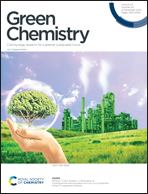Improving the saccharification efficiency of lignocellulosic biomass using a bio-inspired two-stage microreactor system loaded with complex enzymes†
Abstract
Clean and efficient biofuels sourced from lignocellulosic biomass can play a significant role in achieving carbon neutrality. Enzymatic hydrolysis is regarded as a vital step in this process. In this study, inspired by the digestion process of termites, a two-stage microreactor system loaded with enzymes was proposed, for the first time, to hydrolyze wheat straw into monosaccharides efficiently. The two-stage microreactor system is composed of sections loaded with xylanase and cellulase sequentially. When 2.5% (w/w) wheat straw was reacted in the first stage for 24 h, hemicellulose was degraded by 16.8%, leading to an increase in cellulose accessibility by 8.1%. During this process, the specific surface area and porosity of wheat straw also increased, which enabled the cellulase in the second stage to degrade cellulose more efficiently, thereby increasing the glucose production by 89.7% in the second stage within 6 h as compared with the control. The total sugar yield obtained at a total hydrolysis time of 36 h in the two-stage microreactor was 3.0 times that obtained using the microreactor loaded with cellulase only. Therefore, the two-stage microreactor system loaded with enzymes was demonstrated as an effective means for enhancing lignocellulosic conversion under mild conditions.



 Please wait while we load your content...
Please wait while we load your content...